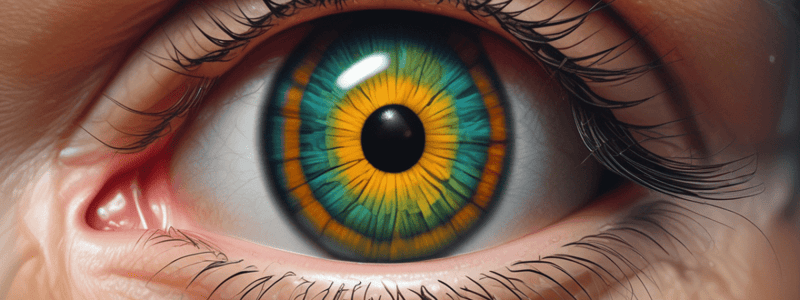Podcast
Questions and Answers
What is the primary purpose of Orthoptists in the assessment of peripheral visual function?
What is the primary purpose of Orthoptists in the assessment of peripheral visual function?
- Diagnosis of disease
- Monitoring of progressive loss
- Decisions about management
- All of the above (correct)
Which of the following is NOT a common principle in the assessment of visual field function?
Which of the following is NOT a common principle in the assessment of visual field function?
- Prolonged testing time (correct)
- Patient response when peripheral stimulus detected
- Occlusion of each eye
- Central, steady fixation
Which of the following modalities for assessing visual field function is NOT commonly available?
Which of the following modalities for assessing visual field function is NOT commonly available?
- Supra-threshold
- Confrontation
- Tomographic (correct)
- Static Threshold
What is the main factor in choosing the approach for assessing visual field function?
What is the main factor in choosing the approach for assessing visual field function?
What is the typical visual field coverage for static perimetry?
What is the typical visual field coverage for static perimetry?
Which algorithm is commonly used for glaucoma assessment in static perimetry?
Which algorithm is commonly used for glaucoma assessment in static perimetry?
What is the main difference between SITA and Standard G algorithms in static perimetry?
What is the main difference between SITA and Standard G algorithms in static perimetry?
What is the primary purpose of using standard practice in static perimetry algorithms?
What is the primary purpose of using standard practice in static perimetry algorithms?
What is the key difference between 'grid' and 'non-grid' test locations in static perimetry?
What is the key difference between 'grid' and 'non-grid' test locations in static perimetry?
What is the main advantage of kinetic perimetry compared to static perimetry?
What is the main advantage of kinetic perimetry compared to static perimetry?
What is the purpose of assessing the blind spot in static perimetry?
What is the purpose of assessing the blind spot in static perimetry?
How does the number of test points (12 vs 24) affect the assessment of the blind spot in kinetic perimetry?
How does the number of test points (12 vs 24) affect the assessment of the blind spot in kinetic perimetry?
What is the purpose of 'post-hoc smoothing' in static perimetry?
What is the purpose of 'post-hoc smoothing' in static perimetry?
How does the type of refractive error impact the accuracy of kinetic perimetry?
How does the type of refractive error impact the accuracy of kinetic perimetry?
What is the primary function of visual field testing?
What is the primary function of visual field testing?
Which of the following statements about the visual field is correct?
Which of the following statements about the visual field is correct?
Which of the following is a primary function of the visual field?
Which of the following is a primary function of the visual field?
What is the rationale behind assessing visual fields in clinical practice?
What is the rationale behind assessing visual fields in clinical practice?
Which of the following is a challenge in assessing visual fields in children?
Which of the following is a challenge in assessing visual fields in children?
What is a marker of test reliability in visual field assessment?
What is a marker of test reliability in visual field assessment?
Which of the following statements about visual field development is correct?
Which of the following statements about visual field development is correct?
What is the purpose of the normative visual field (VF) growth templates shown in the text?
What is the purpose of the normative visual field (VF) growth templates shown in the text?
Which of the following is the LEAST likely reason for including the 'GOLDMANN VS. OCTOPUS' section in the text?
Which of the following is the LEAST likely reason for including the 'GOLDMANN VS. OCTOPUS' section in the text?
Which of the following is the MOST likely reason for the inclusion of the 'READING LIST' section in the text?
Which of the following is the MOST likely reason for the inclusion of the 'READING LIST' section in the text?
What is the MAIN message conveyed by the 'NORMATIVE VF GROWTH' figures in the text?
What is the MAIN message conveyed by the 'NORMATIVE VF GROWTH' figures in the text?
Which of the following is the MOST likely explanation for the inclusion of the 'SUMMARY' section in the text?
Which of the following is the MOST likely explanation for the inclusion of the 'SUMMARY' section in the text?
Which of the following is the MOST likely reason for the inclusion of the 'TYPES OF ASSESSMENT' section in the text?
Which of the following is the MOST likely reason for the inclusion of the 'TYPES OF ASSESSMENT' section in the text?
What is the MAIN purpose of the 'CLINICAL CONDITION' section in the text?
What is the MAIN purpose of the 'CLINICAL CONDITION' section in the text?
According to the studies mentioned, which of the following statements is true regarding kinetic perimetry in children?
According to the studies mentioned, which of the following statements is true regarding kinetic perimetry in children?
Which of the following statements is incorrect regarding the findings of the OPTIC (Study of Optimal Perimetric Testing in Children) studies?
Which of the following statements is incorrect regarding the findings of the OPTIC (Study of Optimal Perimetric Testing in Children) studies?
According to the study by Niederhauser and Mojon, what is the effect of high refractive errors on isopter position in kinetic perimetry?
According to the study by Niederhauser and Mojon, what is the effect of high refractive errors on isopter position in kinetic perimetry?
Which of the following statements is true regarding the use of perimetry in children, based on the information provided?
Which of the following statements is true regarding the use of perimetry in children, based on the information provided?
Which of the following statements is incorrect regarding the use of perimetry in children?
Which of the following statements is incorrect regarding the use of perimetry in children?
According to the information provided, which of the following statements is true regarding the OPTIC (Study of Optimal Perimetric Testing in Children) studies?
According to the information provided, which of the following statements is true regarding the OPTIC (Study of Optimal Perimetric Testing in Children) studies?
Based on the information provided, which of the following statements is correct regarding the use of perimetry in children?
Based on the information provided, which of the following statements is correct regarding the use of perimetry in children?
According to the study by Quinn et al., which of the following statements is true regarding visual field testing in children aged 4-10 years?
According to the study by Quinn et al., which of the following statements is true regarding visual field testing in children aged 4-10 years?
Which of the following statements is incorrect regarding the effect of refractive errors on kinetic perimetry, based on the information provided?
Which of the following statements is incorrect regarding the effect of refractive errors on kinetic perimetry, based on the information provided?
Flashcards are hidden until you start studying
Study Notes
Visual Field Testing
- The visual field represents an area of space from which the visual system gathers information.
- Description of visual pathway (recap):
- Detect motion
- Draw attention (fixation)
Purpose of Visual Field Testing
- Diagnosis of disease
- Monitoring of progressive loss
- Decisions about management
Types of Visual Field Assessments
- Confrontation
- Static
- Kinetic
- Automated
- Manual
- Novel techniques
Static Perimetry
- Features:
- Threshold vs. supra-threshold
- Generally 30/24 degrees
- In UK, HES, Humphrey perimeters are widely used
- Choosing the algorithm:
- SITA and ‘G’ for glaucoma
- SITA vs. Standard
- G vs. TOP
- Strengths and weaknesses:
- Screening (supra-threshold)
- In-depth assessment (threshold)
- Concentration
- Repeatable
- Mistakes can ruin a test
- Automated
- Duration
Kinetic Perimetry
- Features:
- Moving stimuli
- Varying size/intensity
- Full-field assessment
- Can use static points
- Manual/semi-automated
- Defining an isopter
- Assessment of blind spot
- 12 vs. 24 points
- Nomenclature:
- Relative or Absolute scotoma
- Meridian
Visual Field Development in Children
- Normative values:
- Mean (SD) isopter area (deg²)
- Age group (years)
- Growth charts:
- III4e
- I4e
- I2e
- Children aged 5-6 years:
- Mean (SD) isopter area (deg²)
- Median value
- Children aged 13-15 years:
- Red line
- III4e
Challenges of Assessment in Children
- Learning effect
- Fatigue
- Variable responses
Reliability of Testing
- Markers of test reliability
- Adaptations for children
- Indicators and measures
Studying That Suits You
Use AI to generate personalized quizzes and flashcards to suit your learning preferences.




